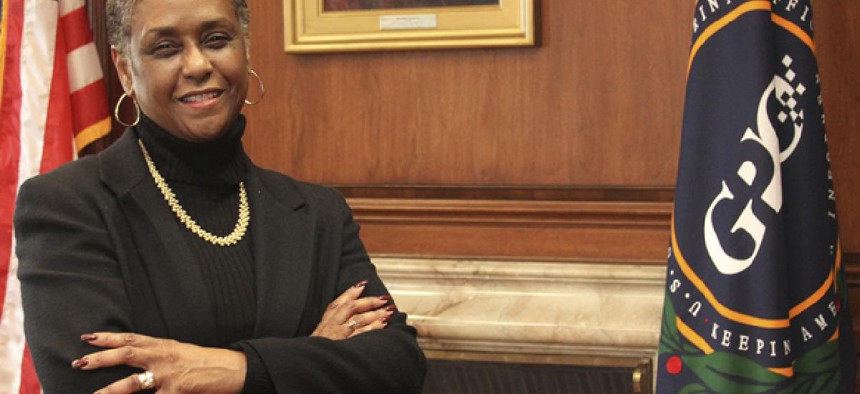
Acting Public Printer Davita Vance-Cooks outlines her agency’s transformation. Government Printing Office
How the public printer is doing more with less
Changing mission and resource constraints require tough decisions on pay, benefits, hiring and travel.
Acting Public Printer Davita Vance-Cooks described as “transformational” the changes she has helped orchestrate at the Government Printing Office, offering the results as “one of many case studies in government operations in an environment of fiscal constraints, intense congressional oversight and justified public scrutiny.”
She detailed the downsizing and reprioritizing required during the current period of austerity as well as GPO’s longer term move from print to digital communications, speaking to a unit of the Association of Government Accountants on Tuesday.
Vance-Cooks, a former health care information technology executive who in January became the first female GPO leader, described its “unique organization and financial structure,” noting the agency, established in 1861, is a “mixture of blue-collar and white-collar workers” and is heavily unionized.
Its three funding sources are congressional appropriations for its own printing needs (the most well-known being the Congressional Record), a separate appropriation for salaries and overhead, and a revolving fund of earnings it brings in from entrepreneurial ventures. Those ventures include production of passport covers with computer chips for reading biometrics, agency smart cards, and general secure credentials such as those used in the Homeland Security Department’s Trusted Traveler program and to manage crowds at Obama's presidential inauguration and the 2012 Super Bowl.
In 2011, Vance-Cooks said the agency “hit a major problem, and was obviously at a crossroads, with declining revenues, rising costs and a shrinking market.” The chief financial officer said if nothing was done, GPO would have to ask Congress for a bailout by 2013.
With the public reading more online and buying fewer printed publications, revenues since 2007 had dropped by 13 percent, she said, while overhead rose by 50 percent. Congress’ session-ending 2011 continuing resolution had a severe impact -- “printing is the first to go,” she said. GPO appropriations were cut by 8 percent in 2011 and 6 percent in 2012.
To “do more with less,” she said, the agency embarked on a four-pronged effort to take the existing mission of keeping the American people informed about their three branches of government and make it more specific, creating a digital platform for one-stop shopping.
GPO developed a strategic plan to serve as a roadmap from 2011 to 2015, sought to bring costs under control (especially overhead), identified strategic capital investments to support its transformation, and stabilized revenues by improving customer relations and finding new market niches.
The key, Vance-Cooks stressed, was communicating to the workforce, to union leaders and management directly to make them active participants. “You can’t communicate too much with employees,” she said, citing use of an intranet, the Internet, newsletters, town hall meetings and even television monitors in elevators.
“Hard, but necessary decisions” followed, she said. Working with Congress -- GPO’s most central customer -- it was agreed that fewer printed copies of the Congressional Record and the Federal Register were needed given the popularity of the online versions. The print order came down by 18 percent, saving $300,000 annually, plus another $400,000 saved through cuts in printing other congressional documents, she said.
Internally, changes included holding the line on salary increases consistent with the governmentwide pay freeze; restricting inside and external hiring by requiring each recommended hire to go through executive review; and requiring all travel be justified in writing and subject to budget conditions and executive review.
“This was considered bureaucratic, but it’s highly effective,” Vance-Cooks said. GPO also restricted overtime, canceled recruitment bonuses and student loan aid, and did away with performance rewards, instead introducing “on-the-spot rewards of nominal amounts.” Managers also slashed training, put new controls on contractors and restricted credit card use.
Finally, employees were offered voluntary buyouts with the goal of trimming 15 percent of the workforce. This took careful planning, she said, and each business unit “had to prepare for individuals walking out the door” by coming up with a strategy -- presented orally to groups -- that would avoid a decline in service levels. “The buyouts were successful. Employees bought into it and the union and management agreed,” she said.
By Jan. 12, Vance-Cooks said, GPO had achieved 95 percent of its goal, and it is further along today. The head count of 1,900 employees is GPO’s lowest this century (it was as high as 8,000 in the past).
For the future, GPO’s transformation produced a task force on long-term strategic investments such as new markets (within the government) for certified security credentials and a task force that has implemented a crackdown on delinquent payments for services provided to other agencies. Everything has to enhance value for the customer, she said. “The days of ‘I wish we could have it,’ ‘Would be nice to have,’ are gone,” she added.
The revamped GPO has emerged with a workforce “with changed skill sets,” Vance-Cooks said, noting her fiscal 2013 budget request is for level funding. “We are now well-positioned to be effective, efficient and relevant” as the agency transforms, she said. “That’s doing more with less.”
NEXT STORY: The Tao of Bubba Watson







